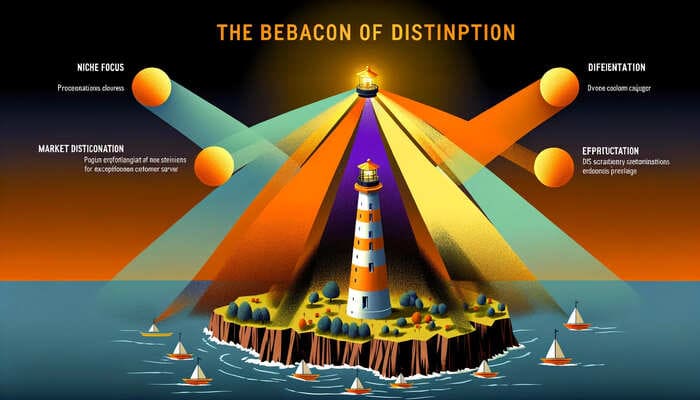10 Proven Strategies to Make Your Business Stand Out

In today’s crowded marketplace, standing out from your competitors has become more crucial than ever. With so many businesses vying for attention, customers have an abundance of choices. To thrive in this competitive landscape, you need to differentiate your business and give customers compelling reasons to choose you over others. In this blog post, we’ll explore 10 proven strategies to help your business stand out and capture the attention of your target audience.
1. Develop a Strong Brand Identity

Your brand identity goes beyond just a logo or colour scheme. It encompasses your brand’s personality, values, and the overall experience you provide to customers. Invest time in defining your brand’s mission, vision, and core values, and ensure that these elements are consistently reflected across all touchpoints, from your website and marketing materials to your customer service interactions.
“Apple is a great example of leveraging a strong brand identity to stand out from competition. Their brand identity is synonymous with sleek design, innovation, and a premium user experience. Every aspect of their brand, from the minimalist logo to the in-store experience, reinforces these core values.”
Additionally, conduct market research to understand how your target audience perceives your brand and identify opportunities to differentiate yourself from competitors. Use this insight to refine your brand messaging, visuals, and overall positioning.
2. Offer a Unique Value Proposition

To truly stand out, you need to offer something that your competitors don’t. Conduct a thorough competitive analysis to identify gaps in the market and unmet customer needs. Use this information to develop a unique value proposition that addresses those gaps and provides a compelling reason for customers to choose your business over others.
“Uber disrupted the taxi industry with its focus on convenience and user-friendliness though ride-sharing services existed before them. Their UVP of “getting a ride at the tap of a button” with cashless payment addressed a pain point of hailing cabs and negotiating fares.”
Your unique value proposition could be a proprietary product or service, an innovative business model, or a superior customer experience. Whatever it is, ensure that it is clearly communicated and consistently delivered across all aspects of your business.
3. Prioritise Exceptional Customer Service

Exceptional customer service is not just about being polite and responsive – it’s about going above and beyond to create a memorable and positive experience for your customers. Start by defining clear customer service standards and training your team to follow them consistently.
“Zappos is a shoe and clothing online retailer, Zappos is legendary for its dedication to customer happiness. Their service goes beyond resolving issues; they empower staff to surprise and delight customers. Stories abound of Zappos representatives going the extra mile, like sending a customer flowers on their birthday or expediting delivery for a special occasion.”
Implement processes and systems that streamline customer interactions, such as a user-friendly website, easy-to-access support channels, and efficient complaint resolution mechanisms. Additionally, encourage your team to personalize their interactions and tailor their approach to each customer’s unique needs and preferences.
Need Help to Level Up Your Business?
Schedule a free consultation call with our team today
4. Embrace Innovation

Innovation is key to staying ahead of the competition and meeting evolving customer needs. Foster a culture of innovation within your organization by encouraging employees to share ideas and experimenting with new approaches. Set aside dedicated resources (time, budget, and personnel) for research and development, and actively seek out new technologies or industry trends that could disrupt your business.
“Amazon a giant in e-commerce, Amazon is renowned for its constant innovation. They experiment with new technologies like drone delivery and voice assistants (Alexa). Their focus on streamlining processes and creating a seamless customer experience through initiatives like one-click buying and Amazon Prime exemplifies their approach.”
Don’t limit innovation to just your products or services – look for opportunities to improve your business processes, marketing strategies, or even your organizational structure. Regularly solicit feedback from customers and industry experts to identify areas for improvement and potential innovation.
5. Leverage Digital Marketing

In today’s digital age, having a strong online presence is non-negotiable. Start by optimizing your website for search engines, ensuring that it is mobile-friendly, fast-loading, and easy to navigate. Develop a comprehensive content marketing strategy that includes blog posts, videos, and social media content to engage with your audience and establish your brand as a thought leader in your industry.
“GoPro, known for its action cameras, leverages user-generated content (UGC) effectively in its digital marketing strategy. They encourage customers to share their adventures captured on GoPro cameras, building a strong online community and showcasing the camera’s capabilities authentically.”
Utilize paid advertising channels like Google Ads, social media advertising, and retargeting campaigns to reach new potential customers and nurture existing leads. Additionally, consider influencer marketing partnerships to tap into new audiences and leverage the trust and credibility of influential figures in your industry.
6. Focus on Niche Markets

Instead of trying to be everything to everyone, consider focusing your efforts on a specific niche market. By specializing in a particular area, you can position your business as an expert and authority in that niche, making it easier to stand out from generalist competitors.
“In the crowded meat industry, Beyond Meat focuses on the niche of plant-based meat alternatives. They target environmentally conscious consumers and those seeking healthier options, offering products that replicate the taste and texture of meat but are made entirely from plant-based ingredients.”
Conduct thorough market research to identify underserved or overlooked niches within your industry, and tailor your products, services, and marketing efforts to meet the specific needs and preferences of that target audience. This level of specialization can help you build a loyal customer base and command premium pricing for your expertise.
7. Build a Community

Building a community around your brand can foster a sense of belonging and loyalty among your customers, setting you apart from competitors who simply sell products or services. Start by identifying common interests, values, or goals that your target audience shares, and create opportunities for them to connect and engage with each other and your brand.
“Owning a Harley-Davidson is more than just a motorcycle; it’s a lifestyle. Harley fosters a strong community through their Harley Owners Group (HOG) program. HOG members participate in rallies, rides, and events, creating a sense of camaraderie and shared passion for the brand.”
This could involve hosting virtual or in-person events, creating social media groups or forums, or developing a loyalty program that rewards active participation and advocacy. Encourage customers to share their experiences, provide feedback, and connect with others who share their interests or challenges.
8. Emphasize Corporate Social Responsibility

In today’s socially conscious climate, consumers are increasingly drawn to businesses that prioritise corporate social responsibility (CSR) and positively impact their communities and the environment. By aligning your business with causes that resonate with your target audience, you can differentiate your brand and build a loyal customer base that shares your values.
“Ben & Jerry’s, this ice cream company is known for its quirky flavours and its social mission. They’ve consistently championed social justice causes, from LGBTQ+ rights to racial equality. They source ingredients fairly and have programs in place to empower their employees and support local communities. Their CSR efforts are a core part of their brand identity, attracting customers who share their progressive values.”
Identify CSR initiatives that align with your brand’s mission and values, and actively promote and participate in these efforts. This could involve charitable donations, volunteering programs, sustainable business practices, or supporting local community organizations. Transparently communicate your CSR efforts through your marketing channels and encourage customers to get involved.
9. Leverage Partnerships and Collaborations

Partnerships and collaborations with complementary businesses or influencers can provide valuable opportunities to reach new audiences and offer unique products or services that your competitors can’t match. Identify potential partners who share a similar target audience or align with your brand values, and explore ways to collaborate on joint marketing campaigns, co-branded products or services, or cross-promotional opportunities.
“Looking beyond coffee, Starbucks has partnered with local musicians and artists to feature their work in stores. This not only supports local artists but creates a unique ambience for customers and differentiates Starbucks from typical coffee chains.”
Additionally, consider partnering with industry influencers or thought leaders to leverage their credibility and reach. These influencers can help promote your brand, provide valuable endorsements, and offer unique insights or perspectives that can enhance your offerings.
10. Continuously Improve and Adapt

Standing out from the competition is an ongoing process that requires continuous improvement and adaptation. Regularly assess the effectiveness of your strategies by soliciting customer feedback, analyzing performance metrics, and monitoring industry trends and competitor activities.
The streaming giant Netflix is a prime example. They constantly analyze customer viewing habits and preferences, using this data to inform their content acquisition and production strategies. Their willingness to experiment with new formats like interactive shows and documentary specials demonstrates their adaptability. By constantly evolving their offerings, Netflix remains at the forefront of the streaming entertainment industry.
Be prepared to pivot and adjust your approach as needed, based on the insights you gather. This could involve refining your marketing tactics, updating your product or service offerings, or even revising your overall brand positioning.
Encourage a culture of continuous learning and growth within your organization, and embrace a mindset of agility and adaptability. By staying agile and responsive to changing market conditions and customer needs, you’ll be better equipped to maintain your competitive edge and continue standing out in your industry.
Conclusion

In a highly competitive market, standing out is essential for attracting and retaining customers. By implementing these 10 strategies, you can differentiate your business, build a loyal customer base, and achieve long-term success. Remember, standing out requires continuous effort, innovation, and a commitment to delivering an exceptional customer experience. Embrace these strategies, and watch your business shine.

